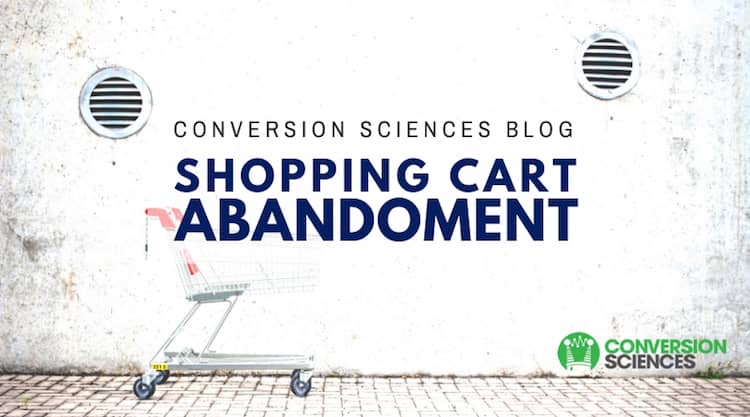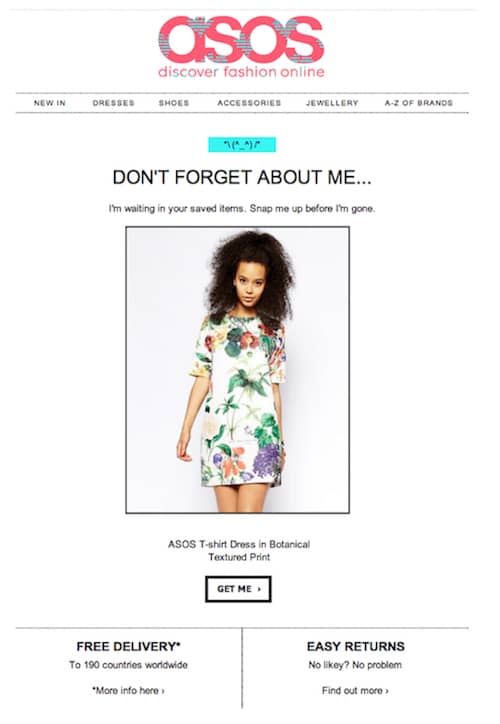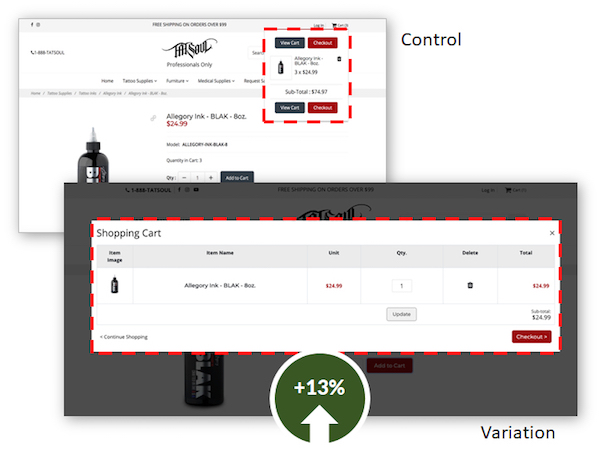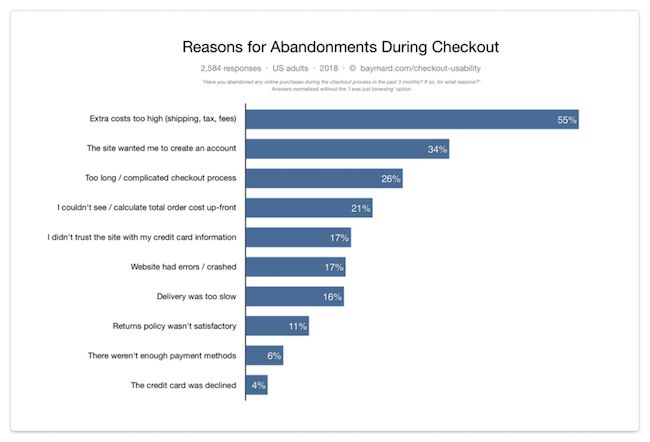Shopping cart abandonment is the most heartbreaking of conversion killers. it is also a fertile place to increase the performance of your website.
Shopping cart abandonment is like cholesterol: There is a good kind and a bad kind. For each there is a strategy for reducing the impact of abandonment on your business.
Good abandoners leave because they aren’t done with their shopping process.
Bad abandoners leave because you surprised them or didn’t provide the information they were looking for.
But it’s 2020, and the number of smartphone dependent shoppers has grown considerably. Thus, we will add one more layer of complexity to the shopping cart abandonment recovery strategy: desktop vs mobile visitors. Why it happens and what to do about it.
Cart Abandonment Rate Formula
The shopping cart abandonment rate formula is quite an easy Key Performance Indicator (KPI) to calculate. Divide the total number of completed purchases by the number of shopping carts created within the same period. Subtract the resulting number from one and multiply by 100 to get the abandonment rate percentage.
Abandonment Rate Calculation Example
- Total number of completed purchases: 335
- Total number of shopping carts created: 500
- Cart abandonment rate: ((500-335) / 500) * 100 = 33%
Definitely not a bad shopping cart abandonment rate. Only 33 out of 100 customers are leaving their carts behind. Do you experience high add to cart but low conversion rates? Keep reading.
The difference between mobile and desktop visitors
“A growing share of Americans now use smartphones as their primary means of online access at home. Today roughly one-in-five American adults are “smartphone-only” internet users – meaning they own a smartphone, but do not have traditional home broadband service.”
Source: Surveys conducted 2013-2019. Data for each year based on a pooled analysis of all surveys containing broadband and smartphone questions fielded during that year.
Traditionally, the desktop computer is a research tool and the smartphone is a dopamine delivery system.
These are two very different uses of internet attached computers.
For someone on a desktop, adding your product to their cart is the end of a journey. For the mobile user, the add to cart is to see how it will feel.
For a growing segment of our population, this is changing. For more and more people, the smartphone is their only source for communication, research, and dopamine. Reliance on smartphones for online access is especially common among younger adults, non-whites and lower-income Americans.
For this reason, we are not going to assume that most mobile visitors are “just shopping.” We are going to look at the causes of checkout abandonment and provide a playbook for eliminating them.
There are also consumers who only buy your products on desktop computers. They would not even think to pick up their phone and buy what you sell.
Let’s dive into how to reduce shopping cart abandonment and improve conversions.
Why do Shoppers Abandon the Checkout Process?
Just as science has identified “good cholesterol” and “bad cholesterol,” there are “good” and “bad” abandoners among your website’s visitors.
The Good Abandoners
Good abandoners leave you as part of their process. They are walking all the way to the edge of buying, even though they are not ready to buy. They are imagining purchasing from you. Yet, they fully intend to continue comparing your offering to alternatives when they start the checkout process.
And they may be hoping you’ll hang on to their selections for when they return. Wish lists and persistent shopping carts are a big help to these abandoners. More on that later.
The challenge is to get them to come back and buy when they are done. We cover some of the strategies for retargeting this visitor later on this article.
The Bad Abandoners
Bad abandoners leave you because they didn’t like what they saw after they got started. These abandoners are bad for you because they are lost opportunities. They were going to buy, but you chased them away with your checkout process.
Your purchase process confounded them, introduced new fears, or asked them to do something they weren’t ready to do, like create an account. Many of these abandoners started the process simply because they didn’t have all the information they needed to make their decision.
This kind of abandonment can be treated by improving the checkout process and by using pricing and shipping strategies.
The five primary “drivers” of Desktop cart abandonment
According to Forrester Research’s report “Understanding Shopping Cart Abandonment,” the five primary “drivers” of cart abandonment are:
- Shipping and handling costs were too high. (Bad abandoners)
- The shopper wasn’t ready to purchase the product. (Good abandoners)
- The shopper wanted to compare prices on other sites. (Good abandoners)
- Product price was higher than the shopper was willing to pay. (Bad abandoners)
- The shopper wanted to save products in his cart for later consideration. (Good abandoners).
Let’s look at what causes bad abandons and then talk about encouraging actual purchases.

High shopping cart abandonment rates are conversion killers. But they are also a fertile place to increase your shop’s performance.
Understanding Mobile Abandonment
There are two kinds of abandoners: Those who were never going to buy and those who would have bought if only…
- If only they could be sure their discount was applied.
- If only they hadn’t been surprised by shipping.
- If only the final price hadn’t been too high.
- If only the form had been easier to enter their discount code.
- If only there was somebody to talk to.
And there are some things that aren’t under your control, but are a particular problem for smartphone users…
- If only my table hadn’t become available.
- If only the movie hadn’t started.
- If only my lunch hour had been longer.
The Impact of Distractions on Mobile Checkout
We have dedicated a whole article to maximizing mobile ecommerce checkout conversions. Take a look.
Top 7 Cart Conversion Optimization Solutions: How to Eliminate the Causes of Cart Abandonment
Consider the following tactics to optimize your online shop cart conversion rate. They may help you reduce or eliminate the causes of shopping cart abandonment.
1. Free Shipping/Free Return Shipping
When a visitor is ready to take action, they instantly begin doubting the sanity of their decision. This is the time to reassure them. Your return policy and shipping offers are great ways to remove their doubts. Getting stuck with a product you don’t want is a real fear, no matter how inexpensive the purchase.
Shipping costs are not usually refunded. Even if you have a generous return policy, buyers can see this as a risk. If your profit margins allow for free shipping both ways, great. Otherwise, adjust your pricing strategy.
In a few words, you should tell them that buying from you is safe if this does not turn out to be a good purchase.
2. Lack of follow up actions after add-to-cart
What do you do when someone adds a product to the cart?
The typical ecommerce site takes the visitor to the Cart page. The problem with this approach is that it takes the visitor out of their shopping experience, maybe before they’ve finished buying.
The answer is typically a “Continue Shopping” button, that takes them to some part of the online retailer site.
But, when a visitor has reached a product page, they are at the bottom of a rabbit hole. It may have involved a search, several category pages, and several product pages. They don’t want to start over.
To solve this problem, ecommerce sites have begun keeping them on the product page after they click Add to Cart, keeping their rabbit hole intact. However, if no visible acknowledgement is given, the visitor loses some of the satisfaction of their action. Or they may think the site is broken. Or they did something wrong.
Make sure that you give your potential buyers a clear signal that they’ve done something amazing. BJ Fogg recommends that you celebrate their action in some way. This should increase the likelihood that they will complete the purchase. These are two examples that signal to the visitor that they have done something amazing.
Nike hovers a Checkout overlay for a few seconds leaving the shopper in the same product page unless they click the “View Bag” or the “Checkout” button.
Or this one from Forever21 that tells their potential buyers they have done something amazing. Complimenting their taste, reiterating their offer to increase cart size (coupon code) and showing them product suggestions.
3. Unsaved Carts
If I come back to the site, I expect my cart to still be there. Saving the visitor’s cart is an important part of abandoned cart remarketing strategies, in which an email or an ad brings them back to their selections.
Save the cart – by implementing a perpetual shopping cart – and find ways to encourage visitors to return.
4. Offer Live Support, Loyalty Programs
Your visitors will buy from you if you treat them well. They will buy again and again. Your willingness to be there for them both before and after the sale will determine their long-term value and your success.
The cart is a great place to show them you care. Have someone available on the phone or in a chat to answer their last minute questions. Let them know that this purchase is part of a reward program that shows you appreciate them.
There is an entire segment of your visitors that care about their relationship with you. Be a good relationship partner.
5. Exit Intent Offers
Remind them about the promotion you are currently offering just before they leave. Stop abandonment on its tracks. On Exit intent pop ups could help you with abandoned shopping bag recovery. Check out these 7 Best Practices for Using Exit-Intent Popovers.
6. Enable Guest Checkout
Maybe your customer doesn’t want to commit to you, yet. Offering guest checkout could make a difference in your cart optimization efforts. Instead of asking them to create an account, test and implement these Guest Checkout Tactics to Grow Ecommerce Sales (with Examples and Ideas)
7. Ask your customers why they are leaving their cart behind
There are many tools to choose from that enable you to set up a short visitor survey to simply ask why they are leaving without checking out. This is a great use of exit-intent overlays. These can be delivered using Justuno, OptinMonster, Optimonk and other tools.
Cart Abandonment Solutions
Ok. We eliminated the causes but that doesn’t completely get rid of the problem. There will still be abandoners.
The most popular cart abandonment solution is the abandoned cart email or email recovery campaign. A great way to re-engage if you were able to get your prospective customer to give you their email. We promise to bring you a new article with the best abandoned cart emails cart and abandonment email examples soon.

ASOS example of abandoned cart email for their email recovery campaign, the most popular cart abandonment solution.
To help you on your quest to lower your shop’s abandonment rate, we will also include examples of abandoned cart text messages, subject lines and email sequence.
If they don’t respond to your emails, not everything is lost. You can always implement an ad retargeting campaign. There are tools that even offer cross-device and cross-platform compatibility and mobile retargeting.
What is a Good Abandonment Recovery Rate?
According to the Baymard Institute, the average abandonment rate on online shoppers is 69.57%. In plain terms, 695 people out of 1,000 are abandoning their carts. A good abandonment recovery rate will be between 10% and 30% of revenue.
If you’d like to boost your website’s bottom line and gently nudge your customers through the checkout process, book a free site review with us.










































